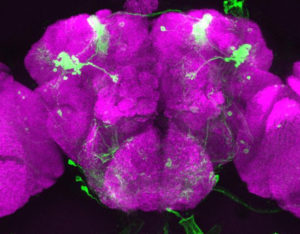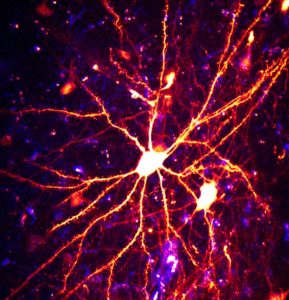Convinced that the brain represented the next frontier of innovation, the White House launched the BRAIN (Brain Research through Advancing Innovative Neurotechnologies) Initiative in 2013. As its momentum builds, it is creating a quiet revolution in neuroscience research by driving interdisciplinary collaborations and delivering new research tools on a massive scale.
The scope of the effort continues to grow. Investment in the BRAIN Initiative has more than quadrupled, from some $100 million for fiscal year 2014, to a proposed $434 million–plus in fiscal year 2017. Its reach encompasses multiple federal agencies — National Institutes of Health (NIH), National Science Foundation (NSF), Defense Advanced Research Projects Agency (DARPA), Intelligence Advanced Research Projects Activity (IARPA), the Food and Drug Administration, and the Department of Energy (DOE) — as well as private funders, such as The Allen Institute for Brain Science, The Simons Foundation, and The Kavli Foundation. The tools and technologies already emerging from the Initiative will help drive brain research into the 21st century and allow researchers to grapple with the driving questions in the field, such as the search for a unifying theory of how the brain works.
Before the President leaves office, he will convene the White House Frontiers Conference to explore the future of American innovation, a centerpiece of which is the BRAIN Initiative. To discuss the Initiative’s early successes, challenges and future directions, The Kavli Foundation brought together a group of researchers and funders who are helping to define it.
The participants were:
- WALTER J. KOROSHETZ – is Director of the National Institute of Neurological Disorders and Stroke at the National Institutes of Health (NIH). He also serves as a co-chair of the NIH’s BRAIN Initiative with Dr. Joshua Gordon, the Director of the National Institute of Mental Health. A collaboration of 10 NIH Institutes and Centers directly contribute funds to a common pool for the support of the BRAIN Initiative.
- JAMES L. OLDS – is the National Science Foundation’s Assistant Director for Biological Sciences, where he has spearheaded many of NSF’s BRAIN Initiative-related efforts. As a molecular neuroscientist and director of George Mason University’s Krasnow Institute of Advanced Studies, Olds led the Decade of the Mind Project, which launched in 2007 and helped shape the BRAIN Initiative.
- CHRISTINE PAYNE – is an associate professor of chemistry and biochemistry at Georgia Institute of Technology in Atlanta. With funding from the NIH/BRAIN Initiative, she is developing new materials that can serve as probes for detecting or modulating the activity of neurons.
- TERRENCE SEJNOWSKI – is Director of the Computational Neurobiology Laboratory at the Salk Institute for Biological Studies in La Jolla, California, and a member of the Kavli Institute for Brain and Mind at the University of California, San Diego. He was a member of the National Institutes of Health working group that developed the scientific vision for the BRAIN Initiative and part of a group of scientists who developed the Brain Activity Map Project, which helped inspire the BRAIN Initiative.
The following is an edited transcript of their roundtable discussion. The participants have been provided the opportunity to amend or edit their remarks.
TKF: The BRAIN Initiative is a “long game” effort, meaning big results may take a decade and longer. Still, are there any early achievements that have caught your attention?
TERRENCE SEJNOWSKI: The major contributions being made right now are toward making sense of signals recorded from hundreds of thousands of neurons recorded at the same time, and from different parts of the brain. Enormous advances are also occurring in the development of devices for recording from human brains. Using these technologies, one surprising thing we’re finding in brains of humans and other species is large-scale traveling waves of neural activity. It’s interesting, everyone thought brain activity would be synchronized across the cortex, but it turns out there are time delays that gives rise to traveling waves. They represent a new way that information is dynamically represented by groups of neurons. This has been found in several brain regions, and it probably is a general property of brain areas that have a layered or repeated structure.

Walter Koroshetz is Director of the National Institute of Neurological Disorders and Stroke at the National Institutes of Health (NIH). (Credit: NIH)
WALTER KOROSHETZ: The National Institutes of Health (NIH) side of the BRAIN Initiative is to develop neurotechnologies, then use them to learn about how brain circuits work. We’re particularly interested in deciphering the language these circuits use to communicate with each other. The tools we’re seeing emerge are just really fantastic. It was hard to imagine that some of these things would actually work. One of the first unique tools to emerge from the NIH BRAIN Initiative is a new generation of something called DREADD (Designer Receptor Exclusively Activated by a Designer Drug) technology, which uses designer drugs to switch specific neurons on and off, allowing researchers to experimentally control circuits in animals’ brains in order to understand their function. This new tool is being used by many labs around the world, and it will enable scientists to precisely modulate neuronal activity. It is also potentially one of the earliest new tools to enter the clinic for neuro/mental disorders.
JAMES OLDS: Several National Science Foundation (NSF)-supported projects are yielding interesting findings. When the BRAIN Initiative was launched, we awarded 36 early concept grants to develop tools that could catch circuits in action. That work is yielding several high-profile tools. For example, one researcher has developed a way to turn brain cells on and off in mice using light. But unlike earlier versions of this technique, in which mice had to be genetically engineered to express light-sensitive proteins, the new method uses viruses to deliver the necessary genes to specific types of brain cells. It is also showing promise in other organisms that are useful for neuroscience such as non-human primates and birds.
Last year, we also ran an ideas lab to map out ways to crack the neural coding that underlies our sense of smell. We know that smells activate specific neurons, but it is still a mystery how such signals are interpreted by the brain and how they shape the decisions made by animals. Research funded from that meeting is helping us begin to understand this, and particularly how different animals use smell to navigate.
TKF: The ultimate aim of neuroscience is to understand the relationship between brain function and behavior. Dr Sejnowski, what will it take to understand how a continuous cascade of rapid-fire brain signals translate into thoughts and behavior?

Terrence Sejnowski is Director of the Computational Neurobiology Laboratory at the Salk Institute for Biological Studies and a member of the Kavli Institute for Brain and Mind at the University of California, San Diego. (Credit: Salk Institute for Biological Studies)
SEJNOWSKI: Neuroscience today is grappling with very large datasets that capture information about behavior and brain activity. Once we have a third dataset capturing information about the connections between neurons, we’ll need to integrate them to understand how they combine to form circuits that produce an enormous range of behaviors. One critical piece will be standardizing how we analyze the patterns of activity being collected from individual neurons.
We also need to develop better theoretical approaches for understanding some general principles about brain function. For example, the brain is a pattern recognizer that can generate abstractions from the inputs it receives from the world. Well, we now have machine-learning algorithms that can recognize patterns in massively complex data sets. Deep learning networks are commercially very successful–Google uses them, for example for speech recognition, language translation and search. They also have some similarities with how the brain might represent data. We need theoreticians to use these and even more powerful algorithms to better understand the brain. Another key step will then be to tie this theoretical approach to brain activity with actual behaviors, and some labs are starting to do this in simple organisms such as zebrafish and fruit flies.
TKF: Along with new ways of recording brain signals, we need new materials that can interface safely with the brain. Dr Payne, is this moving forward as well?
CHRISTINE PAYNE: Currently tools used to measure or modulate neural activity are all made of hard materials, like metals or silicon. But brain tissue is a soft material, so there’s a mismatch that leads to tissue damage and prevents the long-term use of these devices. My group and many others are working on developing electrically active soft materials that can replace these traditional hard materials. My lab focuses on using conducting polymers – materials made up of chains of macromolecules that conduct electricity. These had been used before as coatings, on electrodes, for example. Instead, we’re trying to use them as wires that themselves that can be used to modulate neurons.
TKF: One of the keys to the BRAIN Initiative’s ultimate success is creating new partnerships in science, as well as trying new fields into the study of the brain. Are we seeing progress there as well?
PAYNE: I’m a chemist and the visibility and the excitement of the BRAIN Initiative is how I came into this research. All of the press and the activity drew me in to ask, how I can contribute to this and what tools can I bring to the table? There has also been a big impact on early career scientists. The BRAIN Initiative has created an amazing range of training opportunities for undergraduates and graduate students in multidisciplinary labs, and many will move forward in careers in this area.
The BRAIN Initiative has created an amazing range of training opportunities for undergraduates and graduate students in multidisciplinary labs, and many will move forward in careers in this area.
—Christine Payne, Georgia Institute of Technology

Christine Payne is an associate professor of chemistry and biochemistry at Georgia Institute of Technology. (Credit: Georgia Tech)
KOROSHETZ: At the “State of the Brain” conference Terry organized in May, there was a great group of young investigators showing off the work that they’re doing as part of the BRAIN Initiative, and that was really exciting.
Another boon has been the speed at which many new technologies have been brought into labs throughout the nation. For example, some of the techniques for tracing neuronal projections, can be used tomorrow to help people try and understand the complete set of neuronal connections in a circuit that they’re interested in. Another example is optogenetics, a technique that allows researchers to control neuronal activity with light. New, off-the-shelf optogenetic probes are available for scientists to start using right away.
The BRAIN Initiative is also attracting physical scientists like Christine to neuroscience in record numbers. We’ve had as many engineers apply to the NIH for BRAIN Initiative-funding as neuroscientists. Given its focus on technology development, to me there is no better measure for whether the BRAIN Initiative will succeed.
SEJNOWSKI: Widely disseminating these new methods to smaller labs is hugely important for the future of brain research. Another recent example of a new tool that’s spreading out to labs is the miniature fluorescence microscopes developed by Mark Schnitzer at Stanford. They can be put on the head of a rat to record from thousands of neurons. It’s really terrific technology, and a commercial company will sell it to you for $100,000. But within the last few months, Alcino Silva at the University of California, Los Angeles has reduced the cost to just a few thousand dollars each. He runs workshops to help people build their own microscopes and provides all the necessary software. That same evolution is happening elsewhere. Recording from thousands of neurons simultaneously with microelectrodes used to require hundreds of thousands of dollars and racks of equipment, but the technology will soon be simplified and available for a few thousand dollars.
TKF: A significant number of BRAIN Initiative grants have gone to non-US researchers. Also, other countries such as Israel, Canada, Australia, Japan, China and South Korea have followed suit with major brain research initiatives. What do you think the impact of the BRAIN Initiative has been internationally?
KOROSHETZ: There’s nothing like competition to move science forward, and I think that the BRAIN Initiative has really grabbed the attention of the whole world. Best of all, all the major international brain research efforts you just mentioned are very complementary. Japan is trying to adapt some of the genetic tools we use to study the mouse brain into the marmoset, a non-human primate that may be a better model for understanding the human brain. China’s brain project will develop nonhuman primate models of brain disease using the macaque, an old-world primate that may have more relevance for humans, and also aims to conduct extensive research on human brain diseases and disorders. The European Commission’s Human Brain Project, meanwhile, is heavily focused on creating sophisticated platforms for data analysis and simulations of the human brain.
Almost all neurological and mental health disorders are brain circuit abnormalities. So as tools that help understand how the brain functions improve, they will also, in the long term, have a tremendous impact on how patients are diagnosed and treated.
—Walter Koroshetz, National Institute of Neurological Disorders and Stroke

James Olds is the Assistant Director of the National Science Foundation’s Directorate for Biological Sciences. (Credit: NSF/Photo by Sandy Schaeffer)
The NIH has also developed co-funding relationships with the Brain Canada Foundation, the Australian Medical Research Council and the Lundbeck Foundation in Denmark, where if teams come together with members doing research in these different countries, then the international funding agency will fund the portion of the work done outside the US. The BRAIN Initiative is truly an international effort.
OLDS: Global brain research has been a big focus for the National Science Foundation. A Congressional mandate in 2015 and 2016 required us to hold an international set of conferences aimed at establishing some coordination among global brain research efforts and seeking ways to synergize those efforts. It’s too big a task for any one country. We held a workshop in April at the Kavli Neuroscience Discovery Institute at Johns Hopkins laying out some foundational issues, followed by a fantastic pair of events in September in New York City. Those meetings, which were cosponsored with The Kavli Foundation, brought together global funders and neuroscientists to discuss how to create an International Brain Initiative. The evening’s session was a high-level event at the United Nations that championed the global importance of neuroscience. It also announced the creation of an International Brain Station, a virtual platform for collaboration and data sharing for neuroscientists worldwide.
TKF: Having touched on some of the BRAIN Initiative’s achievements, let’s talk about bottlenecks to progress. One big issue hampering progress is data sharing. Unlike finds such as astrophysics and genomics which embrace team science, neuroscientists still tend to go it alone. Why is data sharing so important, and why has it been so difficult to address?
SEJNOWSKI: It’s a cultural and technological problem. Technologically, most people don’t appreciate how difficult it is to share data, even when the will exists. In fact, there are currently no platforms for making neuroscience data widely accessible. In the Brain 2025 report, which laid out a 10-year scientific vision for the BRAIN Initiative, we recommended that various funders invest in creating a robust data-sharing infrastructure. The only serious progress to date comes from the Europe’s Human Brain Project, where computer scientists have developed what’s called a pipeline that allows different kinds of neuroscience data to be integrated in the form of a large computer simulation.
This is a good example of how different countries can specialize, building on their particular strengths. The US is good at scaling up and creating big data. The Europeans, I think, will ultimately be helpful in putting together data from many different sources. Then, as Walter mentioned, we’ll have the work under way in Japan and China on non-human primate models, which are likely much better models for learning about the human brain than mice.
Once a data-sharing platform exists, though, investigators will have to be willing to part with their data. That will require a culture change because it’s not how most labs work today. I do see that beginning to change because people are realizing that there’s so much more that can be done with their data. So it’s a matter of encouraging both the funding agencies to support the use of large-scale data repositories, as well as the scientists who are gathering the data.
The NSF is envisioning a virtual infrastructure for neuroscience data and technologies, NeuroNex… We’re looking at it as a signature of NSF’s BRAIN Initiative investments for the next decade.
—James Olds, National Science Foundation
KOROSHETZ: There are some platforms being developed, including a Kavli-supported pilot project called Neurodata Without Borders, that is bringing together physiological data from multiple groups. The Allen Brain Science Institute has sophisticated data platforms for some types of neuroscience data. All of these examples are open to the broader neuroscience community.
The lesson we’ve learned at NIH is that if you make a mistake with the data infrastructure, the whole house can come crumbling down. The danger is to build expensive databases that are time consuming but not useful to the people generating the data, or those who wish to study the data. The NIH BRAIN Initiative is keeping those important lessons in mind while pushing forward aggressively on the data front. If you’re putting pressure on individuals to devote time into contributing their data, the infrastructure needs to be as user-friendly as possible both for inputting and mining those data.
TKF: What might a robust data-sharing infrastructure for neuroscience look like?

This image shows the fruit fly brain (magenta), including mushroom body neurons (green), which are unique to the insect brain. By studying gene expression in individual neurons, researhcers can investigate the relationship between genes and behavior. (Credit: Janelia Farm/HHMI – FlyLight)
SEJNOWSKI: Right now, we’re collecting neuron recordings from one animal, anatomy data from another animal, and behavioral data from yet another animal; but in reality every brain is different. Ideally, we’d be collecting all the information from a single brain. No single lab, however, has the tools to do that. So we need to somehow bring together teams that have access to all of the equipment and the know-how to collect this kind of neuroscience data in a systematic way. Such teams would consist of neuroscientists and engineers who can build the industrial-grade systems and create and maintain the software that’s needed. That really requires a centralized infrastructure for all that knowledge and technology to come together.
OLDS: The NSF is envisioning a virtual infrastructure for neuroscience data and technologies, NeuroNex, that has a distributed arrangement – think hubs and spokes. We’re looking at it as a signature of NSF’s BRAIN Initiative investments for the next decade; next year we will spend $30 million on it.
The neurotechnology hubs will foster the development and dissemination of innovative tools, such as research resources and instrumentation, neurotechnologies and behavioral paradigms, that can be used to study many different species. We are also seeking to fund projects in theoretical neuroscience that have the potential to reveal the neural underpinnings of behavior and cognition, also across species.
I’m not sure there will be one unifying theory… I think we will eventually wind up discovering sets of algorithms that explain different processes that occur in the nervous system.
—Terrence Sejnowski, Salk Institute for Biological Studies
TKF: Any chance the BRAIN Initiative will one day uncover a unifying theory of brain function – something that explains all behavior in the brain?

New technologies can enable researchers to better understand how complex behaviors emerge from the activity of brain circuits. This image shows nerve cells in the brain of a songbird that are associated with learning and producing birdsongs. (Credit: Vamsi Daliparthi and Todd Roberts, Department of Neuroscience, UT Southwestern Medical Center)
SEJNOWSKI: I’m not sure there will be one unifying theory, but I do think that theory in brain function will differ from theory in physics. In physics, theory has emerged through the use of equations to describe the physical properties of matter and fluids. But in biological systems, the type of mathematics we need will involve algorithms rather than equations.
Algorithms are basically recipes, step-by-step processes for going from one state to another. I think we will eventually wind up discovering sets of algorithms that explain different processes that occur in the nervous system. For example, one that describes how neural circuits are constructed when you learn something new might be different from one that explains the neural process by which the day’s memories firm up while you sleep. Experiments are starting to hint at this, but we don’t yet have the right theoretical framework to put it all together. I think that’s ultimately where we are heading.
KOROSHETZ: But you know, algorithms for understanding all human brain function are a long-term vision. I don’t think we will see that in the next hundred years. What’s within our short-term grasp is an algorithm that helps understand something more circumscribed, like the respiratory circuit, a spinal cord circuit or the zebrafish brain.
The BRAIN Initiative has a lot to offer this effort, but it’s going to take a long time. Keep in mind, at the NIH, the BRAIN Initiative is a small piece of our neuroscience effort – its budget from the NIH now stands at $150 million, while the budget for neuroscience at the entire agency was $5.7 billion in FY2015. But the impact of the BRAIN Initiative is much bigger than this comparison would lead you to believe – I’d say it is potentiating the overall investment in brain research. Almost all neurological and mental health disorders are brain circuit abnormalities. So as tools that help understand how the brain functions improve, they will also, in the long term, have a tremendous impact on how patients are diagnosed and treated.

